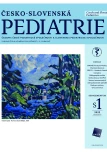Anaphylaxis – do we know what we eat? or “Even a dog knows who gives him food” (Slovak proverb)
Authors:
Pecl Jakub 1; Rybníček Ondřej 1,2
Authors‘ workplace:
Pediatrická klinika Fakultní nemocnice Brno a Lékařské fakulty Masarykovy univerzity v Brně
1; Česká iniciativa pro astma, o. p. s., Praha
2
Published in:
Čes-slov Pediat 2022; 77 (Supplementum 1): 30-34.
Category:
Case Report
doi:
https://doi.org/10.55095/CSPediatrie2022/027
Overview
Although described and named by Charles Richet and Paul Portier some 120 years ago anaphylaxis still represents a diagnostic and therapeutic challenge for patients, their care-givers and healthcare professionals. Multisystemic manifestations of anaphylaxis without any specific pathognomonic symptom make a decision in a critical situation, often requiring immediate treatment, quite difficult. If not recognized and adequately treated in time, especially without immediate adrenaline administration, anaphylaxis may lead to fatal outcome. Clear identification of the causative allergen and its strict elimination significantly reduces the burden of patients and their caregivers. Equipping each patient with rescue kit, repeated (lifelong) education, detailed information about variability of situations that require immediate administration of rescue medication and the proper procedure of adrenaline administration including practical training are essential parts of patient care.
We present a case report of a girl who developed anaphylactic reaction shortly after eating ice cream. This reaction was not adequately managed although her mother was equipped with anaphylaxis rescue kit. Due to complex diagnostic approach the causative allergen was identified and no further allergic “accidents” have been reported so far.
Keywords:
adrenaline – food allergy – anaphylaxis – hazelnut allergy
Sources
1. Simons FE, Ardusso LR, Bilo MB, et al. International consensus on (ICON) anaphylaxis. World Allergy Organ J 2014; 7(1): 9.
2. Lee S, Hess EP, Lohse C, et al. Trends, characteristics, and incidence of anaphylaxis in 2001-2010: A population-based study. J Allergy Clin Immunol 2017; 139 : 182–188.
3. Panesar SS, Javad S, de Silva D, et al. The epidemiology of anaphylaxis in Europe: a systematic review. Allergy 2013; 68 : 1353–1361.
4. Turner PJ, Campbell DE, Motouse MS, et al. Global trends in anaphylaxis epidemiology and clinical implications. J Allergy Clin Immunol Pract 2020; 8 : 1169–1176.
5. Lee S, Hess EP, Lohse C, et al. Trends, characteristics, and incidence of anaphylaxis in 2001–2010: A population-based study. J Allergy Clin Immunol 2017; 139 : 182–188.
6. Aurich S, Dölle-Bierke S, Francuzik W, et al. Anaphylaxis in elderly patients — data from the European Anaphylaxis Registry. Front Immunol 2019; 10 : 750.
7. Pouessel G, Turner PJ, Worm M, et al. Food-induced fatal anaphylaxis: From epidemiological data to general prevention strategies. Clin Exp Allergy 2018; 48(12): 1584–1593.
8. Tanno LK, Gonzalez-Estrada A, Olivieri B, et al. Asthma and anaphylaxis. Curr Opin Allergy Clin Immunol 2019; 19(5): 447–455.
9. Muraro A, Worm M, Alviani C, et al. EAACI guideline: Anaphylaxis (2021 update). Allergy 2022; 77(2): 357–377.
10. Muraro A, Fernandez-Rivas M, Beyer K, et al. The urgent need for a harmonized severity scoring system for acute allergic reactions. Allergy 2018; 73 : 1792–1800.
11. Alqurashi W, Stiell I, Chan K, et al. Epidemiology and clinical predictors of biphasic reactions in children with anaphylaxis. Ann Allergy Asthma Immunol 2015; 115(3): 217–223.
12. Shaker MS, Wallace DV, Golden DBK, et al. Anaphylaxis – a 2020 practice parameter update, systematic review, and Grading of Recommendations, Assessment, Development and Evaluation (GRADE) analysis. J Allergy Clin Immunol 2020; 145(4): 1082–1123.
13. Pouessel G, Cerbelle V, Lejeune S, et al. Anaphylaxis admissions in pediatric intensive care units: follow-up and risk of recurrence. Pediatr Allergy Immunol 2019; 30 : 341–347.
14. Grabenhenrich LB, Dolle S, Rueff F, et al. Epinephrine in severe allergic reactions: the European Anaphylaxis Register. J Allergy Clin Immunol Pract 2018; 6 : 1898–1906.
15. Krčmová I, Novosad J. Anaphylactic symptoms and anaphylactic shock. Vnitr Lek 2019; 65 : 149–156.
16. Ho MH, Heine RG, Wong W, et al. Diagnostic accuracy of skin prick testing in children with tree nut allergy. J Allergy Clin Immunol 2006; 117(6): 1506–1508.
17. Nilsson C, Berthold M, Mascialino B, et al. Allergen components in diagnosing childhood hazelnut allergy: systematic literature review and meta-analysis. Pediatr Allergy Immunol 2019; 31(2): 186–196.
18. Masthoff LJ, Mattsson L, Zuidmeer-Jongejan L, et al. Sensitization to Cor a 9 and Cor a 14 is highly specific for a hazelnut allergy with objective symptoms in Dutch children and adults. J Allergy Clin Immunol 2013; 132(2): 393–399.
19. Aun MV, Kalil J, Giavina-Bianchi P. Adults and children with anaphylaxis in the emergency room. Curr Opin Allergy Clin Immunol 2018; 18(5): 377 – 381.
20. Lieberman JA, Wang J. Epinephrine in anaphylaxis: too little, too late. Curr Opin Allergy Clin Immunol 2020; 20(5): 452–458.
Labels
Neonatology Paediatrics General practitioner for children and adolescentsArticle was published in
Czech-Slovak Pediatrics

2022 Issue Supplementum 1
Most read in this issue
- Summer-associated dermatitides in children
- Tick-borne encephalitis in Slovakia – epidemiology and history
- Tick-borne infections in the conditions of the Czech Republic
- Drowning
